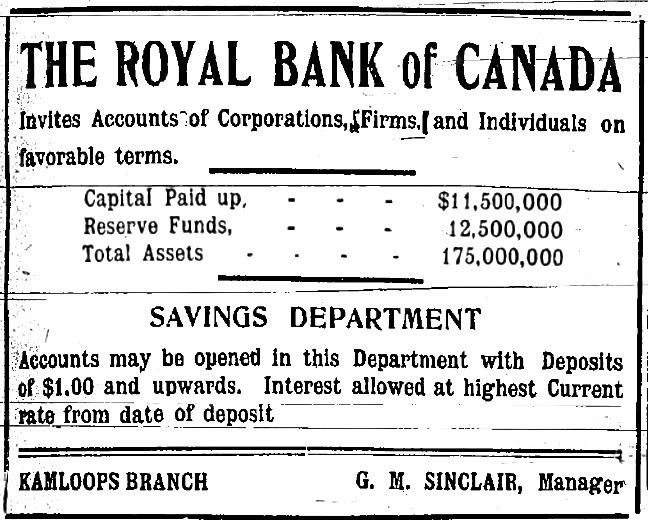Given that the building was completed in 1912 (possibly 1913 if one were to believe the plaque on the building) we will assume that the "Then" photo here was taken not long after, as the adjoining space in the block was not yet filled in. We'll go with 1912.
One of the finest bank buildings erected in the City of Kamloops, this one time Royal Bank Building was built in 1911/1912/1913, during Kamloops' boom years of 1910 to 1915. Unfortunately, not much of the original façade remains in place. While the brick columns remain, their finest features, the Corinthian capitals, are gone, as are the building's arched windows. The striped fabric awnings have now been replaced with contemporary imitations. All that does remain is the original cornice, with ornate brackets interspersed with square modillions underneath and a line of finer dentils below.
No longer the Royal Bank, the building is now occupied by the BDC, the
Business Development Bank of Canada, which is not a bank in the classic sense, but a Crown corporation, the sole shareholder of which is the Government of Canada, which offers
Financing, Venture capital and Advisory Services, to Canadian businesses and entrepreneurs.

ROYAL BANK
205 Victoria Street
1911 - 1912
If the presence of banks is a sign of economic prosperity, then Kamloops was thriving in the early 1900s. A solid bank building stood on the corner of almost every downtown street. One of the finest banks was this brick two-storey structure built in 1911/12 by the Kamloops firm Johnston & Company.
High along the top edge of the building, the remains of an elaborate frieze are still visible. The front façade once featured attached, square brick columns with Corinthian-style capitals. Brick arches with a contrasting raised keystone topped each of the tall first floor windows. The first and second floor west windows were shaded with the striped awnings popular at the time. The west rear door featured a shallow, roofed porch. The unpaved streets were lined with beautiful cluster lights and tall trees.
Today, the bank corner has become part of a busy, commercial district, and the building has had many of its original architectural features changed or modified. It remains a noteworthy example of early Kamloops architecture. It has been occupied by the National Trust since 1972.
From the sign on the building